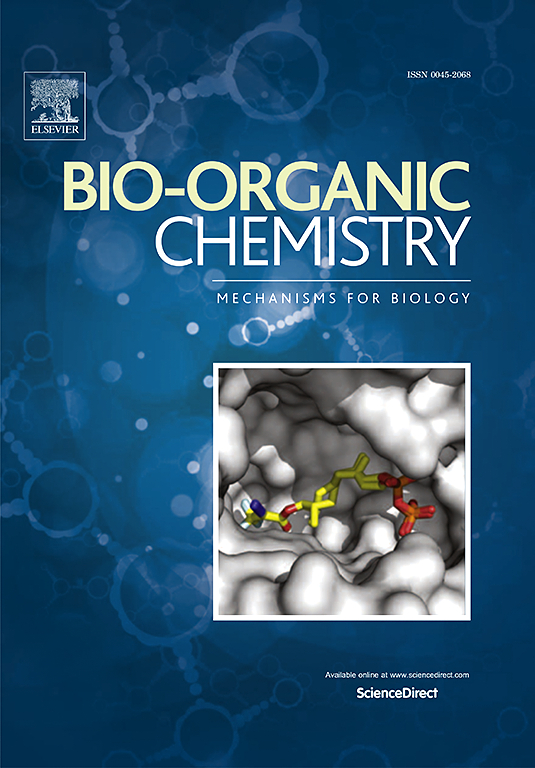Genome mining and characterization of bifunctional Clerodane Diterpene synthase from a fungus Myrothecium sp
IF 4.5
2区 医学
Q1 BIOCHEMISTRY & MOLECULAR BIOLOGY
引用次数: 0
Abstract
Clerodane diterpenoids are a promising group of pharmacological molecules and are rarely discovered in fungi. The clerodane diterpene synthase has not yet been characterized in fungi. Herein, we discovered a gene, mterA, encoding chimeric protein with the bifunction of class II and class I synthases from a fungus Myrothecium sp. by genome mining. Heterologous co-expression of mterA and mterB in engineered yeast led to the production of a clerodane diterpene product (5S, 8R, 9R, 10S)-terpentetriene (1), confirming the existence of a fungi-derived special clerodane diterpene synthase. Site-directed mutagenesis on conserved motifs revealed a strong influence on terpentetriene accumulation. Gene inactivation of mterA indicated that the mter gene cluster was likely cryptic or weakly expressed in the host under the laboratory conditions. Compound 1 exhibited significant inhibitory activity against the plant pathogen Bacillus subtilis with a MIC value of 8 μg/mL and activated the plant immune response. MterA representes the first chimeric bifunctional clerodane diterpene synthase.

真菌Myrothecium sp .双功能氯罗丹二萜合成酶的基因组挖掘与鉴定
氯罗丹二萜是一类很有前途的药理分子,在真菌中很少发现。真菌中的氯烷二萜合成酶尚未被鉴定。通过基因组挖掘,我们从真菌Myrothecium sp.中发现了一个编码II类和I类合成酶双功能嵌合蛋白的基因mterA。mterA和mterB在工程酵母中异种共表达,产生一种cleodane二萜产物(5S, 8R, 9R, 10S)-terpentetriene(1),证实了真菌衍生的cleodane二萜合成酶的存在。保守基序的定点突变对萜烯的积累有很大的影响。mterA基因失活表明,在实验室条件下,mterA基因簇在宿主体内可能是隐蔽性或弱表达的。化合物1对植物枯草芽孢杆菌具有显著的抑制活性,MIC值为8 μg/mL,激活了植物的免疫应答。MterA是第一个嵌合双功能氯代二萜合成酶。
本文章由计算机程序翻译,如有差异,请以英文原文为准。
求助全文
约1分钟内获得全文
求助全文
来源期刊

Bioorganic Chemistry
生物-生化与分子生物学
CiteScore
9.70
自引率
3.90%
发文量
679
审稿时长
31 days
期刊介绍:
Bioorganic Chemistry publishes research that addresses biological questions at the molecular level, using organic chemistry and principles of physical organic chemistry. The scope of the journal covers a range of topics at the organic chemistry-biology interface, including: enzyme catalysis, biotransformation and enzyme inhibition; nucleic acids chemistry; medicinal chemistry; natural product chemistry, natural product synthesis and natural product biosynthesis; antimicrobial agents; lipid and peptide chemistry; biophysical chemistry; biological probes; bio-orthogonal chemistry and biomimetic chemistry.
For manuscripts dealing with synthetic bioactive compounds, the Journal requires that the molecular target of the compounds described must be known, and must be demonstrated experimentally in the manuscript. For studies involving natural products, if the molecular target is unknown, some data beyond simple cell-based toxicity studies to provide insight into the mechanism of action is required. Studies supported by molecular docking are welcome, but must be supported by experimental data. The Journal does not consider manuscripts that are purely theoretical or computational in nature.
The Journal publishes regular articles, short communications and reviews. Reviews are normally invited by Editors or Editorial Board members. Authors of unsolicited reviews should first contact an Editor or Editorial Board member to determine whether the proposed article is within the scope of the Journal.
 求助内容:
求助内容: 应助结果提醒方式:
应助结果提醒方式:


